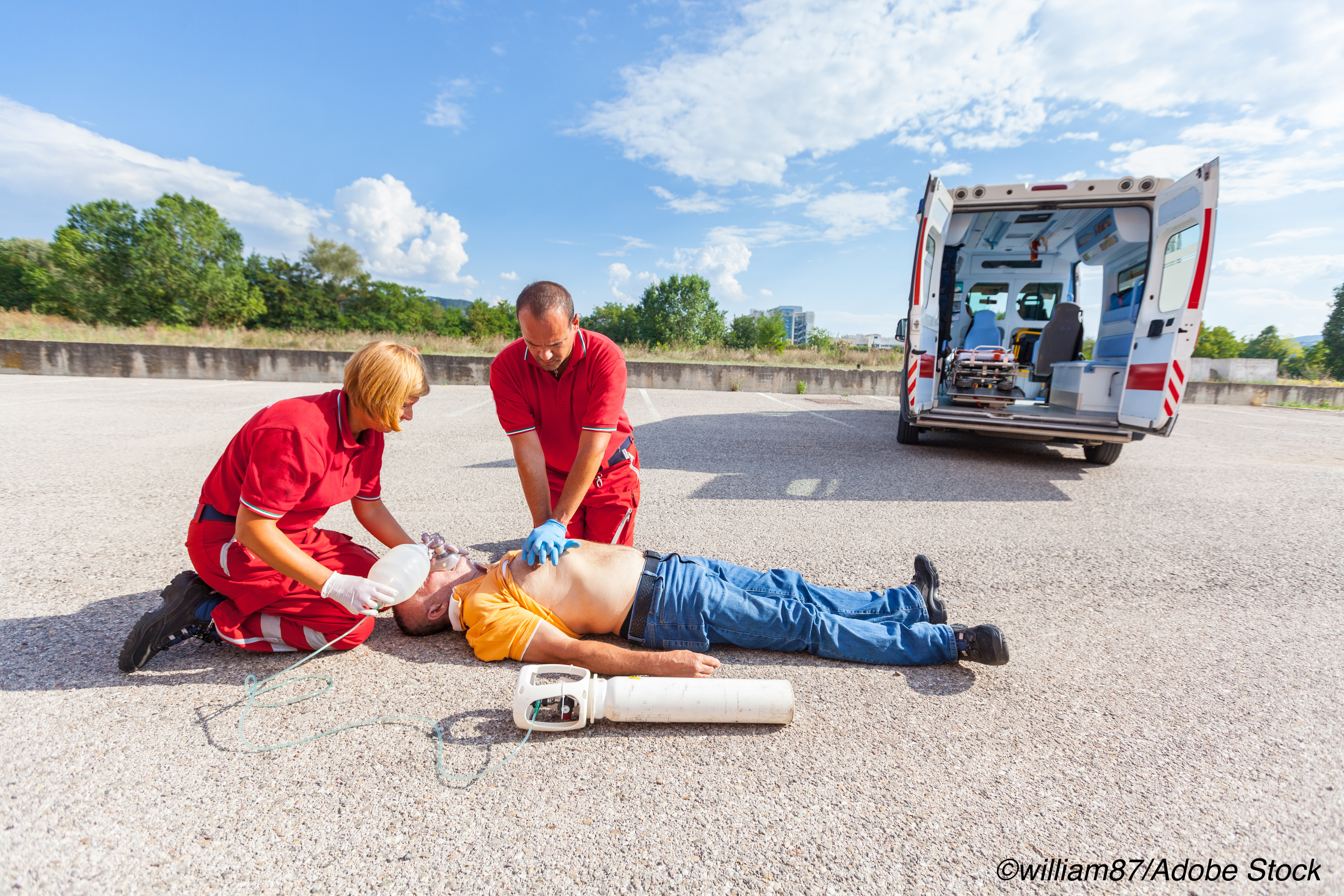
Several clinical and angiographic features of acute myocardial infarction (MI) patients were linked with out-of-hospital cardiac arrest (OHCA), researchers in Japan reported.
In a retrospective study of over 400 patients with acute MI who underwent percutaneous coronary intervention (PCI), 29% were associated with OHCA, according to Yasunori Ueda, MD, PhD, of the National Hospital Organization, Osaka National Hospital, and co-authors.
A multivariate analysis revealed the following factors to be tied to OHCA versus no OHCA:
- Age: odds ratio 0.8 (95% CI 0.7-0.9/5 years, P<0.001).
- Estimated glomerular filtration rate (eGFR): OR 0.8, (95% CI 0.7-0.8/10 ml/min/1.73 m2, P<0.001).
- Peak creatine kinase-myocardial band (CK-MB): OR 1.3 (95% CI 1.2-1.4/102 U/l, P<0.001).
- Use of calcium channel antagonists: OR 0.4 (95% CI 0.2-0.7, P=0.002).
The culprit lesion at the left main coronary artery and the presence of chronic total occlusion (CTO) also were associated with OCHA, they wrote in the Journal of the American College of Cardiology.
“To the best of our knowledge, this is the first study to examine the risk factors of OHCA due to acute MI… Although our cohort still has selection bias of excluding the patients who died before being transported to the hospital by emergency medical services and those who already did not have any signs of life and CPR was terminated at the emergency department, it would be the least biased cohort of acute MI with and without OHCA,” Ueda’s group asserted.
Yes, these results are from a single-center, retrospective, observational study, pointed out Joshua C. Reynolds, MD, MS, of Michigan State University in Grand Rapids, in an editorial comment accompanying the study. But the “novelty of this cohort lies in its clinical setting that mitigates sampling bias inherent in this population,” he argued.
Reynolds explained that “Japanese pre-hospital providers historically do not terminate resuscitation in the pre-hospital environment. Patients without obvious irreversible death (e.g., decapitation, rigor mortis) are transported to hospitals.”
In addition, Japan is the leader in the use of extracorporeal resuscitation (ECPR) in OHCA, he said, and in Osaka in particular, “pre-hospital providers use a portable extracorporeal membrane oxygenation (ECMO) system with pre-hospital veno-arterial cannulation in OHCA.”
“Thus, the primary strength of this work is mitigation of selection bias in the OHCA subset from the use of ECPR in those without conventional ROSC [return of spontaneous circulation] who otherwise may not have survived to receive invasive CA [coronary angiography] and a more liberal selection for invasive CA,” he stated.
The authors also reported that “the use of calcium-channel antagonists was significantly and independently associated with the absence of OHCA..the absence of calcium-channel antagonist use might have reflected the absence of having medical treatment in general; however, it might also be possible that calcium-channel antagonists can prevent OHCA by preventing vasospasm or lethal arrhythmia.” Reynolds called this finding “intriguing,” but cautioned that the association was “hypothesis generating and not indicative of causality.”
Ueda and co-authors looked at 480 patients, 149 of whom had OHCA. They were younger than those without OHCA (63 versus 70 years), were more often male (89% versus 79%), and frequently had more hemodialysis (6% versu 2%).
Less frequent in the OHCA group were hypertension (52% versus 69) and hypercholesterolemia (35% versus 56%). Also, OHCA patients used angiotensin converting enzyme inhibitors or angiotensin II receptor blockers (26% versus 36%), calcium channel antagonists (20% versus 41%), statins (19% versus 28%), and aspirin (19% versus 28%) less frequently than non-OHCA patients.
Ueda’s group found that the culprit lesion at the left main coronary artery (OR 5.3, 95% CI 1.9-15.1, P=0.002), and the presence of chronic total occlusion (OR 2.9, 95% CI 1.5-5.7, P=0.001) were significantly associated with OHCA.
They also reported that predictors of in-hospital mortality for OHCA patients were:
- eGFR: OR 0.7 (95% CI 0.5-0.9/ per 10 ml/min/1.73 m2, P=0.002)
- Peak CK-MB: OR 1.2 (95% CI 1.1-1.3/102 U/l, P<0.001)
- Ventricular tachycardiaventricular fibrillation (VT/VF) as initial rhythm: OR 0.2 (95% CI 0.1-0.7, P=0.015)
- Need for ECPR: OR 2.6 (95%CI 1.0-6.9, P=0.049)
The latter findings indicate that “high eGFR, low peak CK-MB, and VT/VF as initial rhythm, and no need for ECPR are the predictors of in-hospital survival,” the authors stated.
In addition to the aforementioned study limitations, potential selection bias for each type of MI patients, missing lab data, and lack of data on comorbidities in some patients were others
But Ueda’s group noted that other research has “demonstrated the risk factors of lethal arrhythmia in patients with MI; however, in those studies, patients were limited to those with successful resuscitation or to those with cardiac arrest after hospital arrival… Because cardiac arrest patients associated with MI may not be resuscitated successfully until successful reperfusion, studies including only patients after successful resuscitation would not be sufficient to characterize angiographic features of OHCA patients.”
-
Younger age, no use of calcium channel antagonists, worse renal function, larger infarct size, culprit lesion in the left main coronary artery, and having chronic total occlusion were associated with out-of-hospital cardiac arrest (OHCA) in patients with myocardial infarction.
-
The use of calcium-channel antagonists was significantly and independently associated with the absence of OHCA, but the finding is hypothesis generating and does not indicate causality.
Shalmali Pal, Contributing Writer, BreakingMED™
Ueda reported support from, and/or relationships with, Abbott Vascular, Pfizer, Bayer, Daiichi-Sankyo, Astellas, Shionogi, Sanofi, Ono, Nihon Kohden, Amgen Astellas, Actelion, Bristol Myers Squibb (BMS), Medtronic, AstraZeneca, Otsuka, Novartis, Daiichi-Sankyo, Merck Sharp & Dohme, Goodman, Mochida, Takeda, Kowa, Teijin, Astellas, Boston Scientific, Sumitomo Dainippon Pharma, and Eisai. Co-authors reported support from Daiichi-Sankyo, Boehringer Ingelheim, Bayer, BMS, and Pfizer.
Reynolds reported no relationships relevant to the contents of this paper to disclose.
Cat ID: 358
Topic ID: 74,358,254,358,192,925


